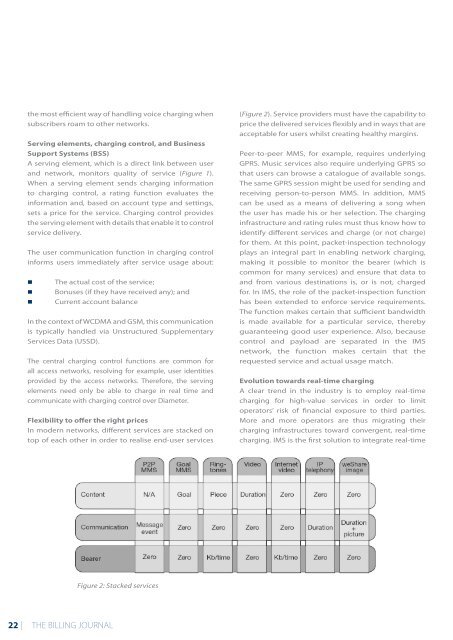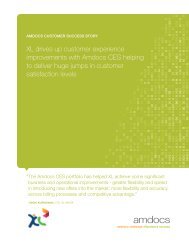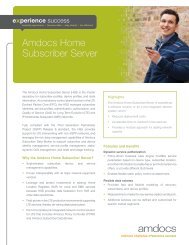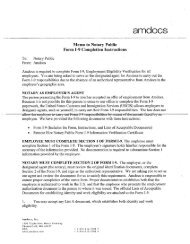The Billing Journal - Amdocs
The Billing Journal - Amdocs
The Billing Journal - Amdocs
You also want an ePaper? Increase the reach of your titles
YUMPU automatically turns print PDFs into web optimized ePapers that Google loves.
the most efficient way of handling voice charging when<br />
subscribers roam to other networks.<br />
Serving elements, charging control, and Business<br />
Support Systems (BSS)<br />
A serving element, which is a direct link between user<br />
and network, monitors quality of service (Figure 1).<br />
When a serving element sends charging information<br />
to charging control, a rating function evaluates the<br />
information and, based on account type and settings,<br />
sets a price for the service. Charging control provides<br />
the serving element with details that enable it to control<br />
service delivery.<br />
<strong>The</strong> user communication function in charging control<br />
informs users immediately after service usage about:<br />
• <strong>The</strong> actual cost of the service;<br />
• Bonuses (if they have received any); and<br />
• Current account balance<br />
In the context of WCDMA and GSM, this communication<br />
is typically handled via Unstructured Supplementary<br />
Services Data (USSD).<br />
<strong>The</strong> central charging control functions are common for<br />
all access networks, resolving for example, user identities<br />
provided by the access networks. <strong>The</strong>refore, the serving<br />
elements need only be able to charge in real time and<br />
communicate with charging control over Diameter.<br />
Flexibility to offer the right prices<br />
In modern networks, different services are stacked on<br />
top of each other in order to realise end-user services<br />
(Figure 2). Service providers must have the capability to<br />
price the delivered services flexibly and in ways that are<br />
acceptable for users whilst creating healthy margins.<br />
Peer-to-peer MMS, for example, requires underlying<br />
GPRS. Music services also require underlying GPRS so<br />
that users can browse a catalogue of available songs.<br />
<strong>The</strong> same GPRS session might be used for sending and<br />
receiving person-to-person MMS. In addition, MMS<br />
can be used as a means of delivering a song when<br />
the user has made his or her selection. <strong>The</strong> charging<br />
infrastructure and rating rules must thus know how to<br />
identify different services and charge (or not charge)<br />
for them. At this point, packet-inspection technology<br />
plays an integral part in enabling network charging,<br />
making it possible to monitor the bearer (which is<br />
common for many services) and ensure that data to<br />
and from various destinations is, or is not, charged<br />
for. In IMS, the role of the packet-inspection function<br />
has been extended to enforce service requirements.<br />
<strong>The</strong> function makes certain that sufficient bandwidth<br />
is made available for a particular service, thereby<br />
guaranteeing good user experience. Also, because<br />
control and payload are separated in the IMS<br />
network, the function makes certain that the<br />
requested service and actual usage match.<br />
Evolution towards real-time charging<br />
A clear trend in the industry is to employ real-time<br />
charging for high-value services in order to limit<br />
operators’ risk of financial exposure to third parties.<br />
More and more operators are thus migrating their<br />
charging infrastructures toward convergent, real-time<br />
charging. IMS is the first solution to integrate real-time<br />
Figure 2: Stacked services<br />
22 | THE BILLING JOURNAL

















